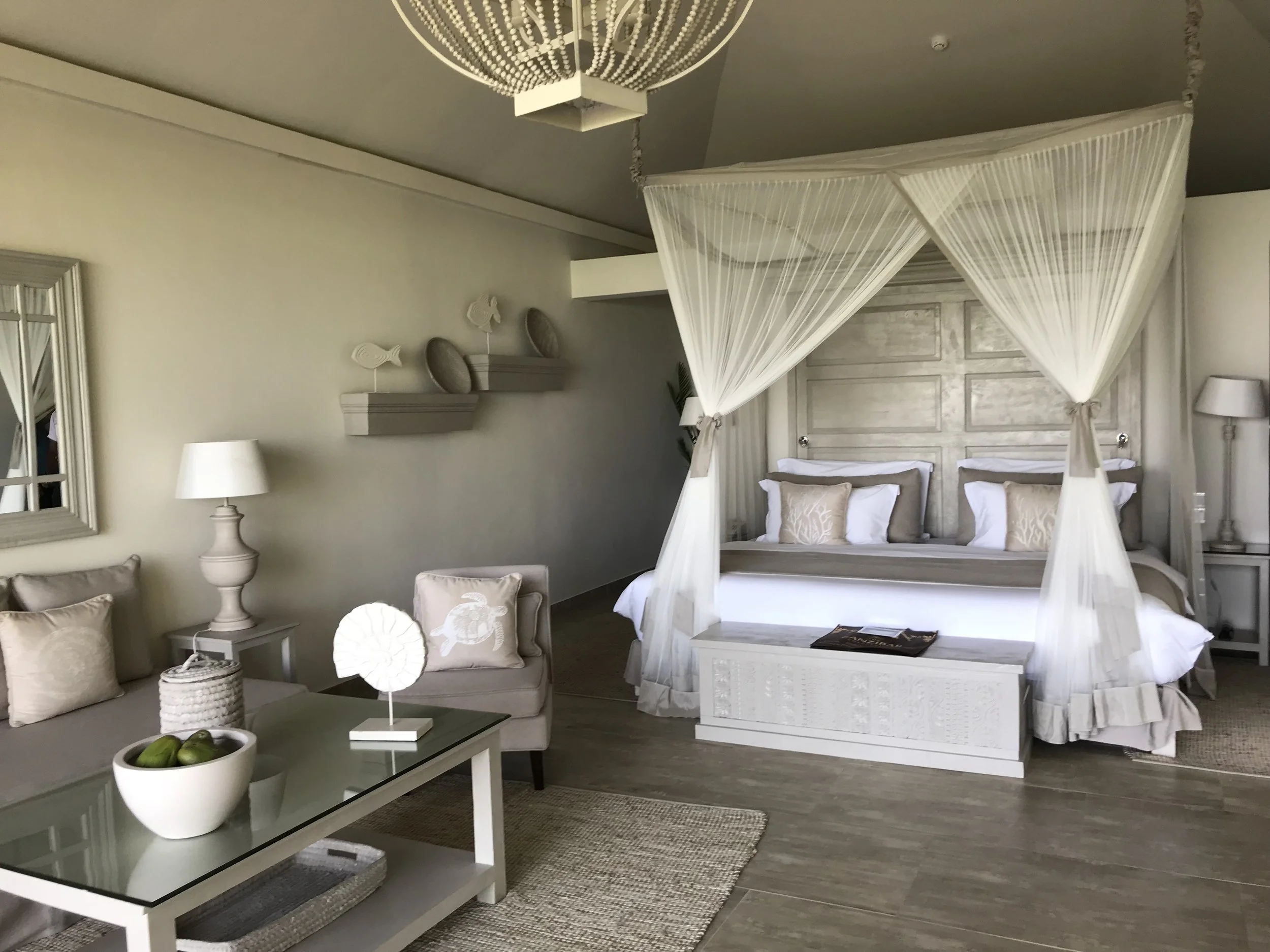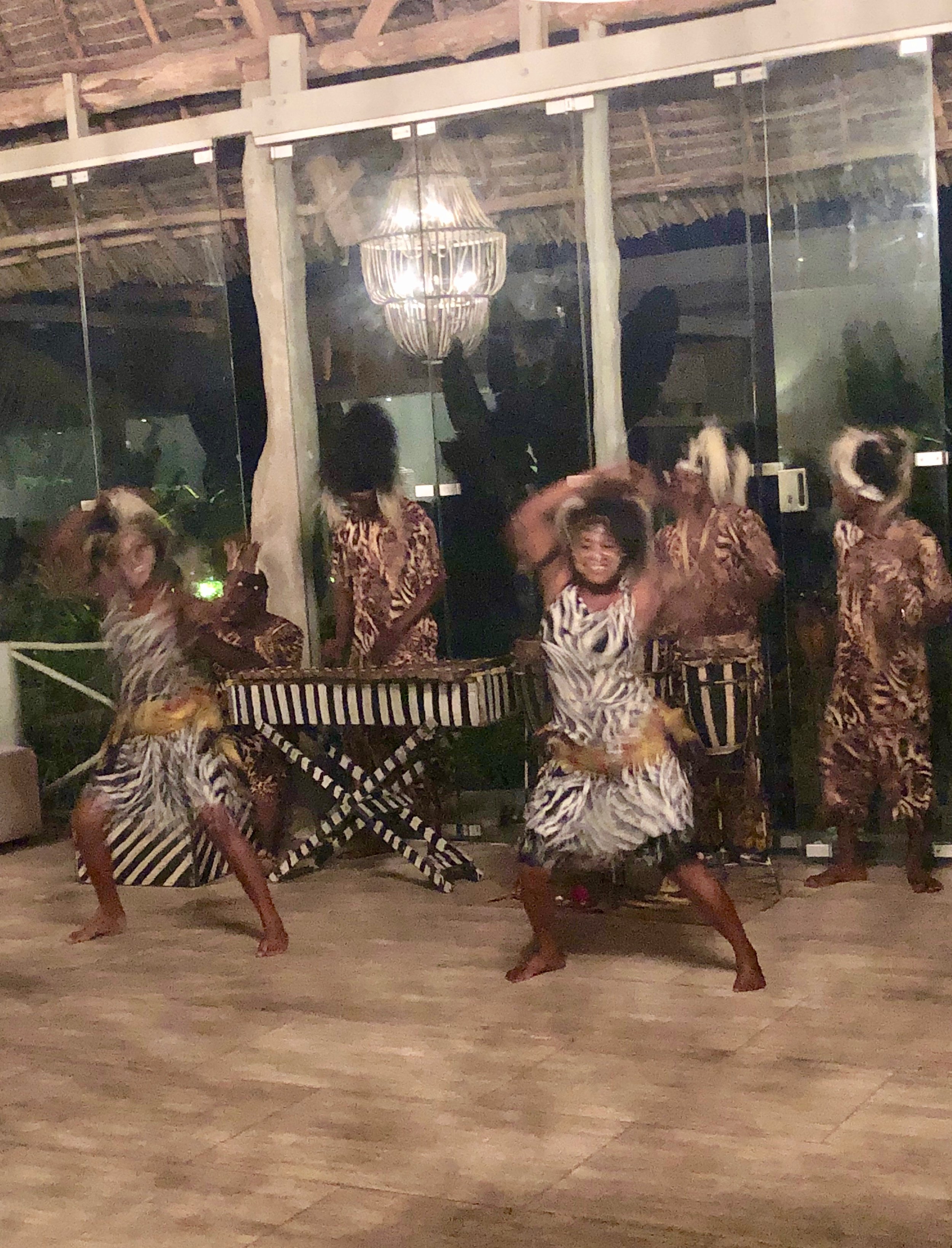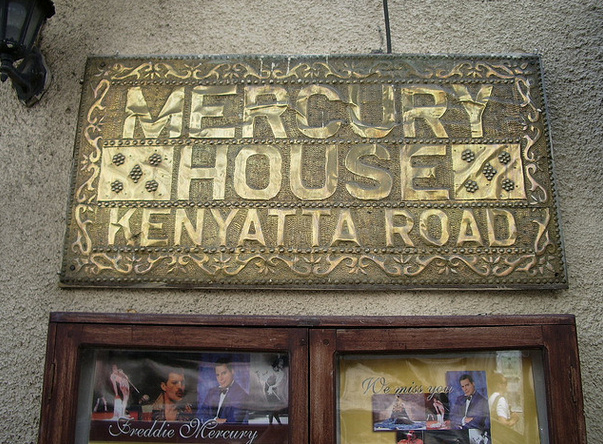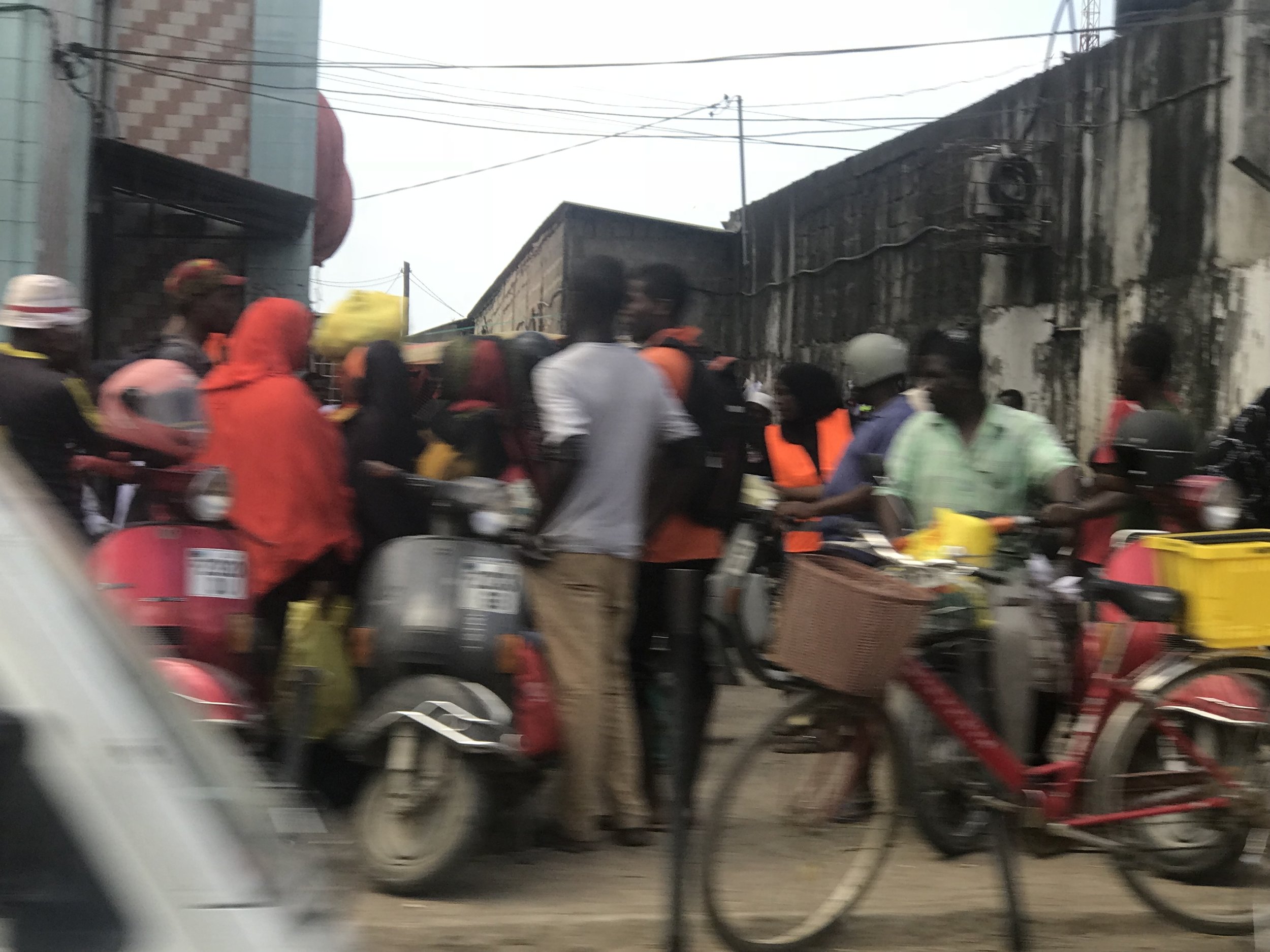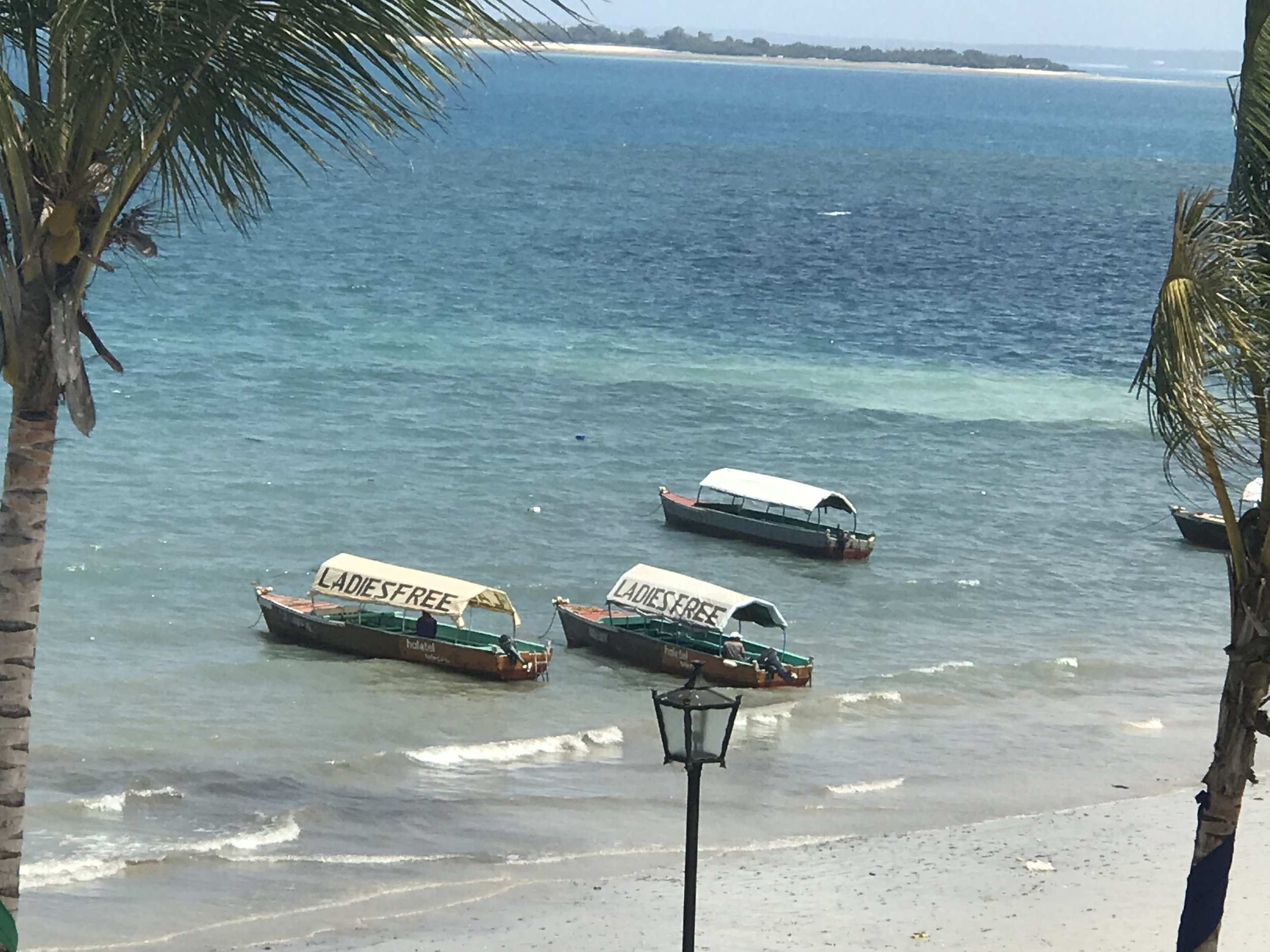February, 2018
We left Kenya, excited to finally get our beach time. Just the name of the island sounded so exotic. A country visited by spice traders from India and Africa who sailed their wooden ships on these very turquoise waters hundreds of years ago. A country lead by Sultans with their turbans and swords. A place where Colobus monkeys and birds swing through the trees, neon flowers bloom seaside, and pods of dolphins splash in the ocean. We were excited to experience the lifestyle here, we hoped Zanzibar could possibly be our go-to-in-proximity-to-Tel-Aviv, version of St. Barths.
Its a straight flight-line from the bush of Nairobi to the islands of Zanzibar, and mid-flight we could even see the snow capped Mt. Killamanjaro. In the short 1.5 hour flight we saw three completely different landscapes. We made our way through the airport, into a lounge where we paid $100 each to enter the country. Our drive through interior of Zanzibar was as lush as Rwanda had been, but not as clean, and not as prosperous. The Zanzibari women also wore layers of bright, mis-matched fabrics. We passed many roadside stands made from tree branches with thatched roofs which shaded the fruits and vegetables that were for sale.
Kilimanjaro
Roadside Work
We booked 5 nights at the Zawadi Hotel (Swahili for ‘Gift’), a luxurious all-inclusive resort where we would be captive of the hotel for Breakfast, Lunch and Dinner. This is the type of place A. refers to as a 5-Star prison. Luckily I had done my research and had a list of restaurants and other resorts to try for at least one meal a day, so we would get out and see some of the island, and some of the hotels we didn’t choose. We checked into one of their 9 Ocean Front Villas. The path to our Villa had two posts with a rope that served as their do not disturb sign. I thought this was a unique touch, although if you forgot that the rope was up, you were at risk of no turndown service, and no room service. The Villa had a terrace that faced the sea with lounge chairs. The room decor was shabby chic-ey, a tonal celebration of whites, creams, and warm grays. Very soothing and well laid out with a living area, desk, and bedroom with giant walk-in closets followed by an enormous bathroom.
Less Shabby More Chic!
We started our stay with lunch at the Beach Bar Restaurant and took in the view - a white sand beach and water that graduated from pale green to blue. A gorgeous scene framed by palms and fuchsia bougainvillea. Thatched umbrellas and lounge chairs sat on terraced levels filled with sand that led down to the beach. This, we were to learn, is the ‘high tide view.’ The low tide view looks more like a sandy beach next to a large salt flat, followed by the sea. You have to walk on a man-made pier until you could find water deep enough to swim.
High Tide
Low Tide
The team at Zawadi was lovely and they worked to make you feel at home. Dinner was served in the more formal Restaurant, with local entertainment that was surprisingly good.
Feathers, Stripes and Spots, Oh my!
Zanzibar is comprised of more than 50 islands which speak multiple languages - Swahili, English, Arabic, French. This is a reflection of their history of occupation. First the Omanis, then the Yemenis ruled Zanzibar for many years. The Portuguese were the first europeans to take control in 1503 for almost 200 years - but that language didn’t stick. Zanzibar spent the next 200 years as a Sultanate of Oman. They installed plantations to grow cloves, which is why Zanzibar is known as the ‘Spice Islands.’ Traders from Yemen, Iran and West India would harness the power of the Monsoon winds to propel their ships to Zanzibar bringing iron, cloth, sugar and dates. When the winds shifted direction, the traders would return home with exports from Zanzibar - ships filled with tortoise shells, ivory, slaves, and cloves and other spices.
By 1890 The British Empire took control for the next 75 years. They managed to have the Shortest War in History on the Island which lasted 45 minutes. It was basically a dispute over the self-proclaimed heir to the throne, the second son of the Sultan who had died, who took power instead of the first son who the British had intended would gain control. The British gave the second son one hour to leave and when he refused, the Royal Navy opened fire on the Palace. After 45 minutes, and shooting down the Palace flag, the war ended. The first son was put in power, and the British maintained control. Just 7 years later, the new Sultan renounced slavery and freed the slaves. The British governors instituted a sewage, garbage and burial systems to clean up the beaches and reduce the odor of all of the above.
Sultans Palace
In 1963 Zanzibar gained Independence from Britain and became a part of mainland Tanzania. Today the major exports are Spices (Cloves, Nutmeg, Cinnamon, and black Pepper), Seaweed, and Raffia. Zanzibar is still trading in people, but today those people are tourists, not slaves. Tourism is the leading source of income for Zanzibar.
Spices to go
One of Zanzibars most important exports was Farrokh Bulsara, who was born in Stonetown, left for India at age 8, and returned to Zanzibar for Middle School. In 1964, Farrokh and his family escaped the Zanzibar Revolution and moved to the UK. Last years success of the film Bohemian Rhapsody (Box Office of $900Million and counting!) memorializes the life and musical success of Farrokh, more famously known as Freddie Mercury.
…borrowed from the Internet
The next day we took a break from the Zawadi to visit their sister hotel the Baraza where we also considered staying. It is larger than the Zawadi at 30 villas, and because their website had featured a ‘Baraza Kids+Teens Club’ and ‘Weddings and Events’ header, we decided to pass. We are still learning how to read reviews on Trip Advisor and to scrutinize Hotel websites to understand the nuance of what is really being said. It’s an art we HAVE NOT mastered after almost 20 years of traveling together. The Baraza is a beautiful arabic/morrocan inspired construction on the beach. Lunch was unfortunately a buffet, so a total disappointment in comparison to the food at the Zawadi. We mentioned to the manager that we were going there for lunch and she responded with a ‘suit-yourself’ sort of shrug. When we returned to the Hotel and expressed our disappointment, she gave a nod that was a more subtle way of saying ‘I thought so.’
We decided to push our boat and snorkel trip a day later since A. was suffering a sore throat and an earache. Instead we booked a guide to take us for a day tour of the Unesco World Heritage Site that is StoneTown. The drive into StoneTown was a blur of local color. Brightly painted buildings, a swirl of fabrics, buckets, bikes, and bags.
Buildings!
Buckets!
Bikes!
Bags!
The first stop was the ‘House of Wonders’ across from the harbor. It was built by a Scottish engineer and at the time it was the tallest building in Zanzibar and the first in Africa to have electricity, an elevator, running water and a telephone. The Wonder part is that it was still standing! Parts of it had collapsed and we were unable to go inside.
House of Wonders
A more majestic shot of The House of Wonders, borrowed from the internet
Across from ‘The House’ was the boardwalk which featured a Silver Jubilee memorial fountain and Portuguese war cannons surrounded by gardens. You could see shipping containers off in the distance and more than a few boats near the shore with ‘Ladies Free’ painted on their canvas coverings. Not sure if that was an advertisement or an invitation. In the distance the guide pointed out ‘Prison Island.’ Apparently the British built a prison that was only ever used as a quarantine for yellow fever and which eventually became a sanctuary for Giant Tortoises.
Prison Island in the background
Near the House of Wonders was the Palace Museum, another dilapidated building in need of repair, but at least we were able to go inside. Our guide (actually, I should call him our driver, as no guiding was really experienced) waited patiently outside and so we were left to explore on our own. After the 45 minute war in 1896 the House became a residence for two reigning Sultans, then the seat of Government in 1913, and even later, it was considered to be the Museum of Zanzibar history.
The Palace contained lots of dusty old furniture - Mahogany banquet tables, Gilded chairs, iron beds and large paintings of both the British Royal family and the Sultans. One floor was dedicated to Sayyida Salme, a princesss and the youngest daughter of one of the Sultans. Her fathers death caused her brothers to battle for the role of Sultan. She ended up with a huge inheritance but left that to run off with the German neighbor, a soldier who had impregnated her. While in Germany she became Emily Reute, converted to Christianity, and had three other children. She wrote the first book by a muslim woman called ‘Memoirs of an Arabian Princess’ about her time in Zanzibar.
A fashion forward leader
A Sultan-worthy bed (or not)
Probably ahead of its time, at the time?
The Palace had elevated walkways that linked the Palace to the Harem - traditionally meant as spaces for muslim women but it is also rumored that the Sultan had 99 concubines, so not sure which definition is more suitable. The walkways also connected other outer buildings and had multiple verandas which looked out to the boardwalk and the sea. Some rooms had windows with a view inside the cemetery walls. Double checking my facts today, I learned about the ‘double tomb’ inside of the cemetery. One half the tomb houses the Sultans amputated legs, which were buried a few years before he actually died. The other half of the tomb contained the rest of his body. I will remind you that while names, dates and historical events will cause me to glaze over, the salaciousness of 99 concubines and a dedicated tomb for amputated legs - now these type of ‘facts’ wake up my curiosity. Learning this now leaves me with many unanswered questions, and zero insight into this mysterious leg-less Sultan. Like, was he the one with the 99 concubines?
Royal Cemetery
We walked the backstreets of historic Stone Town before stopping for (another unmemorable) lunch at the Park Hyatt. The architecture was an eclectic mix of Arabic, Indian and European influences from 1890-1940. I found one very stylish boutique called Doreen Mashika where I purchased artfully packaged spices and a sarong.
After the day of touring StoneTown we decided to hangout and finally get our day at the beach. The problem was that the water was so shallow you had to walk a half a mile to get into enough water deep enough that you could swim. Not the experience we were hoping for. Since we were at the hotel all day we decided to go out for a dinner at a well-rated restaurant called Upendo. We thought we might go for a drink afterward at ‘The Rock’ a restaurant located on a a large rock far enough from shore that you needed to take a boat to get to it. Dinner was awful, but the view kept us entertained. We could watch as groups of people arrived at and left ‘The Rock.’ They struggled to to get on and off the boats at high tide with crashing waves, women tried to keep their dresses from blowing over their heads and to not lose their sunglasses in the heavy winds. It made us happy we didn’t go. We arrived back at Zawadi, confirming for the 4th day in a row that eating anywhere else on this island is NOT a good idea!
The Rock
We woke up to another super windy day, which meant we had to cancel our snorkeling/boat trip entirely. We insisted on going out for yet another disappointing lunch, this time at the White Sand Villas. We did have higher expectations here as it is a Relais & Chateaux property, but their Beach BBQ turned out to be a self-serve type of buffet once you ordered your main course. While the weather foiled our plans to see the island by boat, it did give us an opportunity to watch the hundreds of Kite Surfers catching wind in front of our table.
Kite surfer Sandbar
We returned to the hotel for an afternoon massage and then packed to leave the next day. The driver took the scenic way to the airport. At one point we saw a traffic light. It was the first we had seen in Zanzibar and I mentioned it. The driver laughed in a low sneaky ‘he-he-he’ way, and said “well, we only have three…”
It took several flights to get back to Tel Aviv, and we arrived confident of two things - revolution or no revolution we understood why Freddie Mercury and his family left the island, and, that Zanzibar would definitely not be our go-to-in-proximity-to Tel-Aviv-version of St. Barths.


